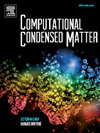期刊简介
Journal Title:Computational Condensed Matter
Computational Condensed Matter is an international academic journal dedicated to the field of computational condensed matter physics. This journal aims to publish high-quality research articles related to theoretical and computational studies of condensed matter. Since its establishment, it has become an important platform for condensed matter physicists, materials scientists, and researchers in related fields to exchange the latest research results. The content of the journal covers a wide range of computational physics research, including but not limited to many body theory, quantum Monte Carlo methods, density functional theory, first principles calculations, material design, and simulation of complex systems. These studies contribute to a deeper understanding of the fundamental properties of condensed matter and guide the development of new materials.
The editorial department of the journal is composed of experienced scientists who ensure that published articles undergo a rigorous peer review process to maintain the academic standards and influence of the journal. In addition, the journal also focuses on promoting interdisciplinary research and encourages the integration of computational physics with research in other disciplines such as biology, chemistry, and engineering. The readership of the magazine includes professors, postdoctoral researchers, doctoral and master's students from universities and research institutions, as well as researchers from industry. By subscribing or accessing library databases, readers can timely obtain cutting-edge research results in computational condensed matter physics, thereby promoting the development of scientific research and technological innovation.
中文简介
《计算凝聚态》是一本专注于计算凝聚态物理领域的国际学术期刊。该期刊旨在发表与凝聚态物质的理论和计算研究相关的高质量研究文章。自成立以来,它已经成为凝聚态物理学家、材料科学家以及相关领域研究人员交流最新研究成果的重要平台。期刊的内容涵盖了广泛的计算物理研究,包括但不限于多体理论、量子蒙特卡洛方法、密度泛函理论、第一性原理计算、材料设计、以及复杂系统的模拟等。这些研究有助于深化对凝聚态物质基本性质的理解,并指导新材料的开发。
期刊的编辑部由经验丰富的科学家组成,他们确保发表的文章经过严格的同行评审流程,以维持期刊的学术标准和影响力。此外,期刊还注重促进跨学科研究,鼓励将计算物理与其他学科如生物学、化学和工程学等领域的研究相结合。杂志的读者群体包括大学和研究机构的教授、博士后研究员、博士生和硕士生,以及工业界的研究人员。通过订阅或通过图书馆数据库访问,读者可以及时获取前沿的计算凝聚态物理研究成果,从而推动科学研究和技术创新的发展。
期刊点评
Computational Condensed Matter由Elsevier出版商出版,收稿方向涵盖PHYSICS, CONDENSED MATTER全领域,平均审稿速度 ,影响因子指数2.6,该期刊近期没有被列入国际期刊预警名单,广大学者值得一试。
WOS分区(数据版本:2023-2024年最新版)
| 按JIF指标学科分区 | 收录子集 | 分区 | 排名 | 百分位 |
| 学科:PHYSICS, CONDENSED MATTER | ESCI | Q3 | 40 / 79 |
50% |
| 按JCI指标学科分区 | 收录子集 | 分区 | 排名 | 百分位 |
| 学科:PHYSICS, CONDENSED MATTER | ESCI | Q3 | 45 / 79 |
43.67% |
名词解释:
WOS即Web of Science,是全球获取学术信息的重要数据库,Web of Science包括自然科学、社会科学、艺术与人文领域的信息,来自全世界近9,000种最负盛名的高影响力研究期刊及12,000多种学术会议多学科内容。给期刊分区时会按照某一个学科领域划分,根据这一学科所有按照影响因子数值降序排名,然后平均分成4等份,期刊影响因子值高的就会在高分区中,最后的划分结果分别是Q1,Q2,Q3,Q4,Q1代表质量最高。
CiteScore分区(数据版本:2024年最新版)
| CiteScore | SJR | SNIP | CiteScore排名 | ||||||||||||||||||||
| 3.7 | 0.379 | 0.673 |
|
名词解释:
CiteScore:衡量期刊所发表文献的平均受引用次数。
SJR:SCImago 期刊等级衡量经过加权后的期刊受引用次数。引用次数的加权值由施引期刊的学科领域和声望 (SJR) 决定。
SNIP:每篇文章中来源出版物的标准化影响将实际受引用情况对照期刊所属学科领域中预期的受引用情况进行衡量。
其他数据
| 是否OA开放访问: | h-index: | 年文章数: |
| 未开放 | -- | 81 |
| Gold OA文章占比: | 2021-2022最新影响因子(数据来源于搜索引擎): | 开源占比(OA被引用占比): |
| 1.31% | 2.6 | |
| 研究类文章占比:文章 ÷(文章 + 综述) | 期刊收录: | 中科院《国际期刊预警名单(试行)》名单: |
| 98.77% | SCIE | 否 |
历年IF值(影响因子):
历年引文指标和发文量:
更多问题
免责声明
本站仅销售经国家新闻出版署批准的合法期刊,不是任何杂志官网,不涉及出版事务。本站仅提供有限咨询服务,需要用户自己向出版商投稿且没有绿色通道,是否录用一切以出版商通知为准。提及的第三方名称或商标,其知识产权均属于相应的出版商或期刊,本站与上述机构无从属关系,所有引用均出于解释服务内容的考量,符合商标法规范。本页信息均由法务团队进行把关,若期刊信息有任何问题,请联系在线客服,我们会认真核实处理。 若用户需要出版服务,请联系出版商。
